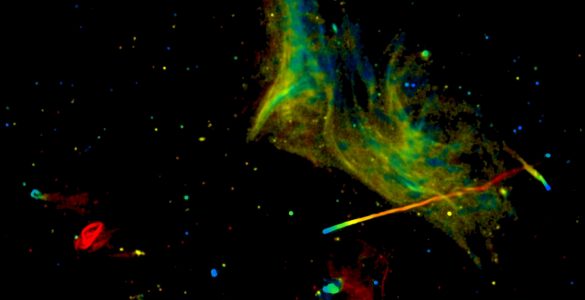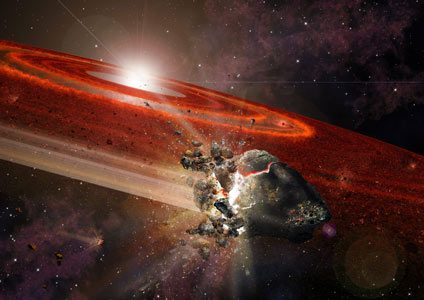Latest NRAO News
News is managed by NRAO News & Public Information. Questions about News? Have a story to share? Want to interview a scientist or create new media about our telescopes?

Thanks to the extraordinary sensitivity of the Karl G Jansky Very Large Array (VLA), astronomers have detected what they believe is the long-sought radio emission coming from a supermassive black hole at the center of one of our closest neighboring galaxies.

Astronomers using the National Science Foundation’s Very Large Array (VLA) have found a long-sought ‘missing link’ between supernova explosions that generate gamma-ray bursts (GRBs) and those that don’t. The scientists found that a stellar explosion seen in 2012 has many characteristics expected of one that generates a powerful burst of gamma rays, yet no such burst occurred.

A pair of images of a young star, made 18 years apart, has revealed a dramatic difference that is providing astronomers with a unique, ‘real-time’ look at how massive stars develop in the earliest stages of their formation.

Researchers using the Karl G. Jansky Very Large Array (VLA) have produced the most detailed image yet of a fascinating region where clusters of hundreds of galaxies are colliding, creating a rich variety of mysterious phenomena visible only to radio telescopes.

For the first time, astronomers have caught a multiple-star system in the beginning stages of its formation, and their direct observations of this process give strong support to one of several suggested pathways to producing such systems.

Astronomers using the National Science Foundation’s Very Large Array (VLA) found surprisingly energetic activity in what they otherwise considered a ‘boring’ galaxy, and their discovery provides important insight on how supermassive black holes can have a catastrophic effect on the galaxies in which they reside.

Looking back at the science news released by NRAO in 2014, the staff scientists at NRAO selected what they believed were the top 10 stories based on both scientific impact and public interest.

A new system that makes the Karl G Jansky Very Large Array two telescopes in one has been completed and its scientific operations are underway.

With the help of citizen scientists, a team of astronomers has found an important new example of a very rare type of galaxy that may yield valuable insight on how galaxies developed in the early Universe.

The VLA visitor center film, Beyond the Visible: The Story of the Very Large Array, received a prestigious Interpretive Media Award from the National Association for Interpretation (NAI).





